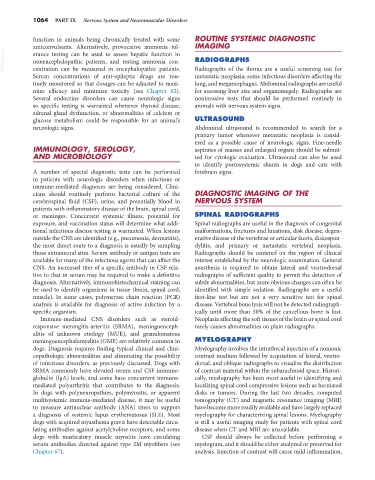Page 1092 - Small Animal Internal Medicine, 6th Edition
P. 1092
1064 PART IX Nervous System and Neuromuscular Disorders
function in animals being chronically treated with some ROUTINE SYSTEMIC DIAGNOSTIC
anticonvulsants. Alternatively, provocative ammonia tol- IMAGING
VetBooks.ir erance testing can be used to assess hepatic function in RADIOGRAPHS
nonencephalopathic patients, and resting ammonia con-
centration can be measured in encephalopathic patients.
metastatic neoplasia, some infectious disorders affecting the
Serum concentrations of anti-epileptic drugs are rou- Radiographs of the thorax are a useful screening test for
tinely monitored so that dosages can be adjusted to maxi- lung, and megaesophagus. Abdominal radiographs are useful
mize efficacy and minimize toxicity (see Chapter 62). for assessing liver size and organomegaly. Radiographs are
Several endocrine disorders can cause neurologic signs noninvasive tests that should be performed routinely in
so specific testing is warranted whenever thyroid disease, animals with nervous system signs.
adrenal gland dysfunction, or abnormalities of calcium or
glucose metabolism could be responsible for an animal’s ULTRASOUND
neurologic signs. Abdominal ultrasound is recommended to search for a
primary tumor whenever metastatic neoplasia is consid-
ered as a possible cause of neurologic signs. Fine-needle
IMMUNOLOGY, SEROLOGY, aspirates of masses and enlarged organs should be submit-
AND MICROBIOLOGY ted for cytologic evaluation. Ultrasound can also be used
to identify portosystemic shunts in dogs and cats with
A number of special diagnostic tests can be performed forebrain signs.
in patients with neurologic disorders when infectious or
immune-mediated diagnoses are being considered. Clini-
cians should routinely perform bacterial culture of the DIAGNOSTIC IMAGING OF THE
cerebrospinal fluid (CSF), urine, and potentially blood in NERVOUS SYSTEM
patients with inflammatory disease of the brain, spinal cord,
or meninges. Concurrent systemic illness, potential for SPINAL RADIOGRAPHS
exposure, and vaccination status will determine what addi- Spinal radiographs are useful in the diagnosis of congenital
tional infectious disease testing is warranted. When lesions malformations, fractures and luxations, disk disease, degen-
outside the CNS are identified (e.g., pneumonia, dermatitis), erative disease of the vertebrae or articular facets, diskospon-
the most direct route to a diagnosis is usually by sampling dylitis, and primary or metastatic vertebral neoplasia.
those extraneural sites. Serum antibody or antigen tests are Radiographs should be centered on the region of clinical
available for many of the infectious agents that can affect the interest established by the neurologic examination. General
CNS. An increased titer of a specific antibody in CSF rela- anesthesia is required to obtain lateral and ventrodorsal
tive to that in serum may be required to make a definitive radiographs of sufficient quality to permit the detection of
diagnosis. Alternatively, immunohistochemical staining can subtle abnormalities, but more obvious changes can often be
be used to identify organisms in tissue (brain, spinal cord, identified with simple sedation. Radiographs are a useful
muscle). In some cases, polymerase chain reaction (PCR) first-line test but are not a very sensitive test for spinal
analysis is available for diagnosis of active infection by a disease. Vertebral bone lysis will not be detected radiograph-
specific organism. ically until more than 50% of the cancellous bone is lost.
Immune-mediated CNS disorders such as steroid- Neoplasia affecting the soft tissues of the brain or spinal cord
responsive meningitis-arteritis (SRMA), meningoenceph- rarely causes abnormalities on plain radiographs.
alitis of unknown etiology (MUE), and granulomatous
meningoencephalomyelitis (GME) are relatively common in MYELOGRAPHY
dogs. Diagnosis requires finding typical clinical and clini- Myelography involves the intrathecal injection of a nonionic
copathologic abnormalities and eliminating the possibility contrast medium followed by acquisition of lateral, ventro-
of infectious disorders, as previously discussed. Dogs with dorsal, and oblique radiographs to visualize the distribution
SRMA commonly have elevated serum and CSF immuno- of contrast material within the subarachnoid space. Histori-
globulin (IgA) levels, and some have concurrent immune- cally, myelography has been most useful in identifying and
mediated polyarthritis that contributes to the diagnosis. localizing spinal cord compressive lesions such as herniated
In dogs with polyneuropathies, polymyositis, or apparent disks or tumors. During the last two decades, computed
multisystemic immune-mediated disease, it may be useful tomography (CT) and magnetic resonance imaging (MRI)
to measure antinuclear antibody (ANA) titers to support have become more readily available and have largely replaced
a diagnosis of systemic lupus erythematosus (SLE). Most myelography for characterizing spinal lesions. Myelography
dogs with acquired myasthenia gravis have detectable circu- is still a useful imaging study for patients with spinal cord
lating antibodies against acetylcholine receptors, and some disease when CT and MRI are unavailable.
dogs with masticatory muscle myositis have circulating CSF should always be collected before performing a
serum antibodies directed against type 2M myofibers (see myelogram, and it should be either analyzed or preserved for
Chapter 67). analysis. Injection of contrast will cause mild inflammation,

